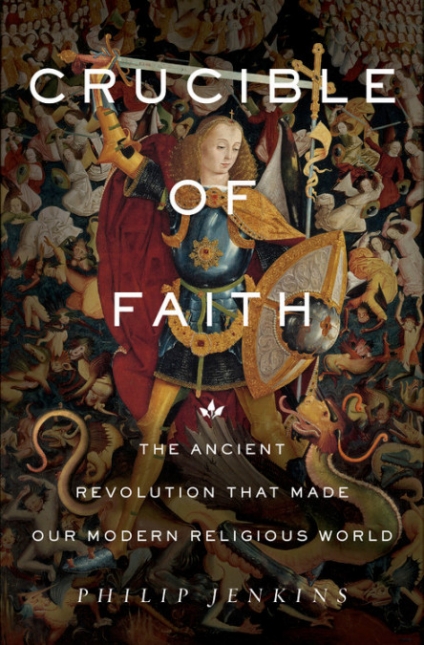A remarkably complex exegesis on the Bible’s most challenging texts.

If one spends enough time reading the Bible, that strange, disparate collection of ancient texts, one begins to notice that something significant has changed between the end of Chronicles (for Jews) or Malachi (for Christians) and the beginning of Matthew. Those differences, at least for the Christian believer, might well become uncomfortable.
Why is there a hell in the New Testament and not the Old? What happened to Sheol, the shadowy abode of the dead from earlier Jewish thought? Where did all the angels come from in the Gospels, and where were they in the Old Testament? What can account for the absence of the resurrection of the dead from the Tanakh, which was the only scripture Jesus and his followers knew?
The answer, according to Baylor University historian Philip Jenkins, is “a tectonic theological shift” between 250 BCE and the birth of Jesus that “left an indelible mark on the scriptures.” In Crucible of Faith, Jenkins tells the story of this time of political and religious upheaval in ancient Judaism and, in the process, shows us something about the world we inhabit today.
That story is mind-bendingly complex. It begins in the years after Israel has returned from exile in Babylon and rebuilt the temple, stories readers may know from the biblical books of Ezra and Nehemiah. But for non-specialists, that familiarity will be short-lived. Jenkins quickly plunges into nearly forgotten histories where, after the break-up of the empire of Alexander the Great, Judea is squeezed between the powerful Ptolemaic (Egyptian) and Seleucid (Syrian-based) empires.
Ethnic cleansing and violence were common, intrigue a constant part of life for the priestly and political elite. In response to this unrest, Jewish writers began to explore new theological and literary paths, and the genre of apocalyptic writing was born. Though Daniel and Second Zachariah emerged within this tumult, they were important, but not genre-defining works at the time.
That distinction, Jenkins writes, belongs to the 38,000-word, 108-chapter tome that today we call 1 Enoch. One Enoch was quoted by the New Testament author Jude, and Jewish writers at the time found it exhilarating. But it was destined to be mostly forgotten by both Jews and Christians. A look at the first chapters of the text explains why.
The authors (there were several) take the reader through the deepest abysses and hells and relate the strangest visions (one is usually called the Animal Apocalypse). We read the names of angels, something rare before this time. There is much speculation about a passage in Genesis — one of the weirdest passages in scripture — where, according to 1 Enoch’s interpretation, in primeval times, fallen angels slept with human women, and giants came from their union.
One Enoch had major political significance, too, though it would be anachronistic to separate political and religious concerns here. Political critique would become a standard feature of apocalyptic writing generally, from the messianic readings of the biblical book of Daniel through Revelation’s cryptic, drama-filled criticism of Rome. It was, in fact, the reason the genre was invented.
But the most important wrinkle 1 Enoch and other apocalyptic works threw into ancient Near Eastern politics at this time was fairly simple: a radicalized monotheism. It is the change which accounts for many of the others. In documents from pre-exilic Israel, one runs across evidence of henotheism, the idea that there are other gods than the one your tribe worships.
By Jesus’ time, the gods worshipped by Greeks, Romans, and other oppressive empires were increasingly thought to be frauds. We see this in 1 Enoch, in the Dead Sea Scrolls found at Qumran, and in many other works Jenkins examines. For these ancient writers, Zeus, Isis, and the emperor were not gods at all since there is only one God, and He was on Israel’s side.
Some readers might wonder why Jenkins did not trace the birth of radical monotheism in Israel to what historians of religion call the “Axial break.” That term indicates a time a few hundred years before Jenkins’ “crucible era,” when metaphysical statements start to appear in the writings of the prophets and “theoretic culture,” as Robert Bellah put it, began to form in Israel for the first time.
But Jenkins’ story is a cultural and political one, and including an examination of this earlier period would have needlessly complicated an already extraordinarily complex narrative. As it stands, Crucible of Faith manages to weave an astonishing number of movements, texts, and political figures into one story, a story that illuminates connections between biblical books and forgotten political movements, Jewish sectarianism, Greek Gnosticism, Roman realpolitik, and the rise of early Christianity.
Above all, Jenkins shows us how political turmoil in an ancient, provincial kingdom at the friction point between empires helped form the beliefs held by billions in the world today. For that reason alone, Crucible of Faith is quite an achievement.
[Editor's note: This review originally ran in 2017.]
Joel Looper is a Ph.D. candidate in religion at the University of Aberdeen.

